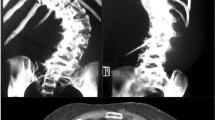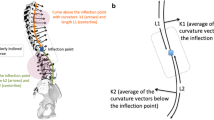Abstract
Inadequate understanding of risk factors involved in the progression of idiopathic scoliosis restrains initial treatment to observation until the deformity shows signs of significant aggravation. The purpose of this analysis is to explore whether the concave–convex biases associated with scoliosis (local degeneration of the intervertebral discs, nucleus migration, and local increase in trabecular bone-mineral density of vertebral bodies) may be identified as progressive risk factors. Finite element models of a 26° right thoracic scoliotic spine were constructed based on experimental and clinical observations that included growth dynamics governed by mechanical stimulus. Stress distribution over the vertebral growth plates, progression of Cobb angles, and vertebral wedging were explored in models with and without the biases of concave–convex properties. The inclusion of the bias of concave–convex properties within the model both augmented the asymmetrical loading of the vertebral growth plates by up to 37% and further amplified the progression of Cobb angles and vertebral wedging by as much as 5.9° and 0.8°, respectively. Concave–convex biases are factors that influence the progression of scoliotic curves. Quantifying these parameters in a patient with scoliosis may further provide a better clinical assessment of the risk of progression.




Similar content being viewed by others
References
Adams M, McNally D, Dolan P (1996) Stress distribution inside intervertebral discs. The effects of age and degeneration. J Bone Joint Surg 78:965–972. doi:10.1302/0301-620X78B6.1287
Adams M, McNally D, Wagstaff J, Goodship A (1993) Abnormal stress concentrations in lumbar intervertebral discs following damage to the vertebral bodies: a cause for disc failure? Eur Spine J 1:214–221. doi:10.1007/BF00298362
Aubin CE, Dansereau J, Petit Y, Parent S, De Guise J, Labelle H (1998) Three-dimensional measurement of wedged scoliotic vertebrae and intervertebral discs. Eur Spine J 7:59–65. doi:10.1007/s005860050029
Delorme S, Petit Y, De Guisse J, Aubin CE, Dansereau J (2003) Assessment of the 3-D reconstruction and high-resolution geometrical modeling of the human skeletal trunk from 2-D radiographic Images. IEEE Trans Biomed Eng 50:989–998. doi:10.1109/TBME.2003.814525
Dimeglio A, Ferran J (1990) Three-dimensional analysis of the hip during growth. Acta Orthop Belg 56:111–114
Gilsanz V, Boechat M, Roe T, Loro M, Sayre J, Goodman W (1994) Gender difference in vertebral body sizes in children and adolescents. Radiology 190:673–677
Goel K, Clausen J (1998) Prediction of load sharing among spinal components of a C5–C6 motion segment using the finite element approach. Spine 23(6):684–691. doi:10.1097/00007632-199803150-00008
Grant J, Oxland T, Dvorak M, Fisher C (2002) The effects of bone mineral density and disc degeneration on the structural property distribution in the lower lumbar vertebral endplates. J Orthop Res 20:1115–1120. doi:10.1016/S0736-0266(02)00039-6
Guerin H, Elliott D (2006) Degeneration affects the fibber reorientation of human annulus fibrosus under tensile load. J Biomech 39:1410–1418. doi:10.1016/j.jbiomech.2005.04.007
He Y, Qiu Y, Zhu Z (2006) Quantitative analysis of types I and II collagen in the disc annulus in adolescent idiopathic scoliosis. Stud Health Technol Inform 123:123–128
Horst M, Brinckmann P (1981) Measurement of the distribution of axial stress on the end-plate of the vertebral body. Spine 6(3):217–232. doi:10.1097/00007632-198105000-00004
Huynh A, Aubin CE, Mathieu P, Labelle H (2007) Simulation of progressive spinal deformities in duchenne muscular dystrophy using a biomechanical model integrating muscle and vertebral growth modulation. Clin Biomech (Bristol, Avon) 22:392–399. doi:10.1016/j.clinbiomech.2006.11.010
Kamibayashi L, Wyss U, Cooke T, Zee B (1995) Trabecular microstructure in the medial condyle of the proximal tibia of patients with knee osteoarthritis. Bone 17(1):27–35. doi:10.1016/8756-3282(95)00137-3
Keller T, Hansson T, Abram A, Spengler D, Panjabi M (1989) Regional variations in the compressive properties of lumbar vertebral trabeculae. Effects of disc degeneration. Spine 14(9):1012–1019. doi:10.1097/00007632-198909000-00016
Keller T, Ziv I, Moeljanto E, Spengler D (1993) Interdependence of lumbar disc and subdiscal bone properties: a report of the normal and degenerated spine. J Spinal Disord 6(2):106–113. doi:10.1097/00002517-199304000-00003
Kilincer C, Inceoglu S, Sohn M, Ferrada L, Bakirci N, Benzel E (2007) Load sharing within a human thoracic vertebral body: an in vitro biomechanical study. Turk Neurosurg 17:167–177
Li S, Patwardhan A, Amirouche F, Harvey R, Meade K (1995) Limitations of the standard linear solid model of intervertebral disc subject to prolonged loading and low-frequency vibration in axial compression. J Biomech 28:779–790. doi:10.1016/0021-9290(94)00140-Y
McNally D, Adams M (1992) Internal intervertebral disc mechanics as revealed by stress profilometry. Spine 17(1):66–73. doi:10.1097/00007632-199201000-00011
Mehlman C, Araghi A, Roy D (1997) Hyphenated history: the Hueter–Volkmann law. Am J Orthop 26:798–800
Meir A, Fairbank J, Jones D, McNally D, Urban J (2007) High pressures and asymmetrical stresses in the scoliotic disc in the absence of muscle loading. Scoliosis 2:4. doi:10.1186/1748-7161-2-4
Mitton D, Rumelhart C, Hans D, Meunier P (1997) The effects of density and test conditions on measured compression and shear strength of cancellous bone from the lumbar vertebrae of ewes. Med Eng Phys 19:464–474. doi:10.1016/S1350-4533(97)00001-5
Nachemson A (1965) In vivo discometry in lumbar discs with irregular nucleograms. Some differences in stress distribution between normal and moderately degenerated discs. Acta Orthop Scand 36:418–434
Nanjo Y, Morio Y, Nagashima H, Hagino H, Teshima R (2003) Correlation between bone mineral density and intervertebral disc degeneration in pre- and postmenopausal women. J Bone Miner Metab 21:22–27. doi:10.1007/s007740300004
Nielson D, McEvoy F, Madsen M, Jensen J, Svalastoga E (2007) Relationship between bone strength and dual-energy X-ray absorptiometry measurements in pigs. J Anim Sci 85:667–672. doi:10.2527/jas.2006-025
Oshia R, Tencer A, Ching R (2003) Effect of loading on endplate and vertebral body strength in human lumbar vertebrae. J Biomech 36:1875–1881. doi:10.1016/S0021-9290(03)00211-2
Parent S, Labelle H, Skalli W, De Guise J (2004) Vertebral wedging characteristics changes in scoliotic spines. Spine 29(20):E455–E462. doi:10.1097/01.brs.0000142430.65463.3a
Patwardhan A, Havey R (1999) A follower load increases the load-carrying capacity of the lumbar spine in compression. Spine 24(10):1003–1009. doi:10.1097/00007632-199905150-00014
Perie D, Curnier D, De Gauzy J (2003) Correlation between nucleus zone migration within scoliotic intervertebral discs and mechanical properties distribution within scoliotic vertebrae. Magn Reson Imaging 21:949–953. doi:10.1016/S0730-725X(03)00216-9
Perie D, De Gauzy J, Curnier D, Hobatho M (2001) Intervertebral disc modeling using a MRI method: migration of the nucleus zone within scoliotic intervertebral discs. Magn Reson Imaging 19:1245–1248. doi:10.1016/S0730-725X(01)00452-0
Price J, Oyajobi B, Russell R (1994) The cell biology of bone growth. Eur J Clin Nutr 48:131–149
Rumancik S, Routh R, Pathak R, Burshell A, Nauman E (2005) Assessment of bone quality and distribution in adult lumbar scoliosis: new dual-energy X-ray absorptiometry methology and analysis. Spine 30:434–439. doi:10.1097/01.brs.0000153344.06682.b2
Schultz A, Andersson G, Ortengren R, Nachemson A (1982) Loads on the lumbar spine. Validation of a biomechanical analysis by measurement of intradiscal pressures and myoelectric signals. J Bone Joint Surg 64:713–720
Stokes I (2007) Analysis and simulation of progressive adolescent scoliosis by biomechanical growth simulation. Eur Spine J 16:1621–1628. doi:10.1007/s00586-007-0442-7
Stokes I, Aronsson D, Dimock A, Cortright V, Beck S (2006) Endochondral growth in growth plates of three species at two anatomical locations modulated by mechanical compression and tension. J Orthop Res 24(6):1327–1333. doi:10.1002/jor.20189
Stokes I, Gardner-Morse M (2004) Muscle activation strategies and symmetry of spinal loading in the lumbar spine with scoliosis. Spine 29:2103–2107. doi:10.1097/01.brs.0000141182.42544.1f
Sylvestre PL, Villemure I, Aubin CE (2007) Finite element modeling of the growth plate in a detailed spine model. Med Biol Eng Comput 45:977–988. doi:10.1007/s11517-007-0220-z
Urban M, Fairbank J, Bibby S, Urban J (2001) Intervertebral disc composition in neuromuscular scoliosis: changes in cell density and glycosaminoglycan concentration at the curve apex. Spine 26(6):610–617. doi:10.1097/00007632-200103150-00010
Villemure I, Aubin CE, Dansereau J (2002) Simulation of progressive deformities in adolescent idiopathic scoliosis using a biomechanical model integrating vertebral growth. J Biomed Eng 124(6):784–790
Villemure I, Aubin CE, Grimard G, Dansereau J, Labelle H (2001) Progression of vertebral and spinal three-dimensional deformities in adolescent idiopathic scoliosis: a longitudinal study. Spine 26(20):2244–2250. doi:10.1097/00007632-200110150-00016
Wilke H, Neef P, Caimi M, Hoogland T, Claes L (1999) New In vivo measurements pressures intervertebral disc in daily life. Spine 24(8):755–762
Wolff J (1892) Das Gesetz der Transformation der Knoche. Hirshwald, Berlin
Yerramalli C, Chou A, Miller G, Nicoll S, Chin K, Elliot D (2007) The effect of nucleus pulposus crosslinking and glycosaminoglycan degradation on disc mechanical function. Biomech Model Mechanobiol 6:13–20. doi:10.1007/s10237-006-0043-0
Acknowledgments
Funded by the Natural Sciences and Engineering Research Council of Canada, Medtronic Sofamor Danek and the Canada Research Chair Program.
Author information
Authors and Affiliations
Corresponding author
Rights and permissions
About this article
Cite this article
Driscoll, M., Aubin, CE., Moreau, A. et al. The role of spinal concave–convex biases in the progression of idiopathic scoliosis. Eur Spine J 18, 180–187 (2009). https://doi.org/10.1007/s00586-008-0862-z
Received:
Revised:
Accepted:
Published:
Issue Date:
DOI: https://doi.org/10.1007/s00586-008-0862-z




